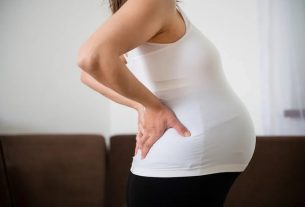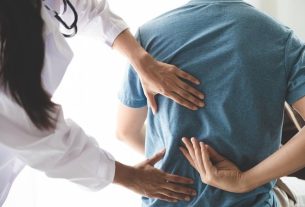Back pain on the left side usually occurs due to common everyday situations, such as carrying heavy objects, having poor posture or making very repetitive movements, which end up causing muscle injuries or even the compression of some nerves. These situations can usually be treated at home with some precautions, such as resting and applying hot compresses, for example.
However, pain on the left side of the back may also be indicative of a more serious condition, such as kidney stones or rib fractures, especially when the pain is very intense or lasts for many days, situations that require immediate medical attention. . See more causes of rib pain.
It is important to consult an orthopedist or general practitioner whenever pain appears on the left side of the back, especially when it is frequent or accompanied by other symptoms, so that the characteristics of the pain and the presence of other symptoms can be assessed and, therefore, be diagnosed and the most appropriate treatment initiated.
Main causes
The main causes of pain on the left side of the back are:
1. Muscle injury
Most back pain has a muscular origin, as the spine is the body’s support base, and can appear after physical activities, lifting or carrying heavy objects, poor posture, or even blows to the region.
Muscle pain generally worsens with movement, brings a feeling of pain in the form of heaviness or tightness, and can end up affecting daily activities due to the discomfort it causes.
What to do: Some ways to relieve muscle tension are to apply a warm compress to the region for 15 minutes, twice a day, or apply an anti-inflammatory ointment. Furthermore, it is also important to avoid exertion during this period and maintain correct posture on a daily basis, as well as stretch to reduce muscle tension and alleviate discomfort. See other ways to relieve pain due to muscle injuries.
2. Herniated disc
A herniated disc is a problem that can occur in the lower back and arises when a vertebral disc, located between the vertebrae of the spine, moves out of its correct position, or ruptures, which ends up causing compression of the nerves in the region. Understand better how a herniated disc arises.
Generally, a herniated disc causes pain in the spine, which can affect the left or right side, and be localized or radiate to other locations such as the legs and arms. Furthermore, depending on the region in the affected spine, other symptoms may appear such as a burning sensation, tingling or a feeling of weakness in the legs.
What to do: The treatment of a herniated disc should be carried out by an orthopedist who may recommend physiotherapy or the use of analgesic and anti-inflammatory medications, such as paracetamol or ibuprofen, to help relieve pain and reduce inflammation. In more serious cases, the doctor may also recommend surgery. See the main treatment options for herniated discs.
3. Sciatic nerve compression
Compression of the sciatic nerve can arise due to problems in the spine, such as a herniated disc, for example, causing symptoms such as pain in the spine on the left or right side, as well as a tingling, stabbing or shock sensation that radiates from the lower back. up to the leg and foot.
What to do: you can stretch or use cold-heat therapy, for example, as they have anti-inflammatory and analgesic effects, helping to relieve pain. However, if the pain does not improve or symptoms such as difficulty walking, sitting or carrying out daily activities appear, you should consult an orthopedist who can recommend the most appropriate treatment. See how treatment for sciatic nerve compression is carried out.
4. Kidney stones
Kidney stones, also known as kidney stones or renal lithiasis, can cause strong and intense pain in the lower back, which starts suddenly, and can be accompanied by nausea, vomiting, pain or burning when urinating, for example. example. Know how to identify all the symptoms of kidney stones.
Furthermore, kidney stone pain does not improve with rest or in specific positions, and can radiate to both sides, left and/or right.
What to do: It is important to seek medical help immediately or the nearest emergency room to start treatment, which can be done with the use of medicines to relieve pain or surgery to remove the stone and avoid complications such as obstruction of the passage of urine, which can cause accumulate in the kidney and cause kidney swelling or kidney infection.
In the case of people who are already undergoing some type of treatment for kidney stones, if the pain is mild, they should rest, be adequately hydrated, be careful with their diet and take painkillers recommended by their doctor. See what nutritional precautions are taken for those with kidney stones.
5. Fissure or fracture of the ribs
When pain appears on one side of the back that starts suddenly or even a milder pain that remains for weeks and ends up weakening the region, it may indicate that there has been a fracture. A classic symptom is difficulty breathing due to pain.
This type of fracture is more common in the elderly due to the weakening of the bones caused by small blows or even wear and tear. Athletes are also susceptible to this condition due to blows, especially in high-impact sports, such as wrestling or football.
What to do: If a rib fracture is suspected, it is recommended to consult a doctor or go to the emergency room for tests, such as a chest X-ray, to confirm the condition and begin appropriate treatment, which is normally done with analgesics to alleviate the pain. pain while recovering from the fracture. See some important precautions to alleviate symptoms during rib fracture treatment and avoid complications.
6. Heart attack
Although a heart attack can cause back pain on the left side, this is a rarer situation. This is because the heart attack initially causes very intense pain in the chest that radiates to the left arm and shoulder. This back pain is characterized as a strong stitch that can give the impression of a bad feeling that gets worse with exertion.
Heart attacks mainly affect elderly people or those who live with untreated chronic conditions such as high blood pressure, high cholesterol and diabetes.
What to do: In cases of suspected heart attack, SAMU should be called immediately by calling 192 or the person should be taken to the emergency room quickly. Check out the first aid steps that should be followed when you suspect a case of a heart attack.
7. Scoliosis
Scoliosis is a lateral deviation of the spine, in the shape of a C or S, that affects many young people and adolescents, leading to the appearance of some symptoms that can be noticed over time and according to the severity of the deviation, such as a shoulder that is more higher than the other, one side of the hip more inclined upwards or persistent muscle pain. Understand better what scoliosis is and how to identify it.
Although it is rare, scoliosis can cause pain in the spine, on the left or right side, and most of the time there is no known cause. However, in some cases it may be related to a lack of physical activity, poor posture or sitting or lying down for a long time with a crooked spine, for example.
What to do: Depending on the degree of spinal deviation, the orthopedist may recommend physical exercises in milder cases, such as swimming, physiotherapy or wearing an orthopedic brace. In more serious cases, in which there is a large deviation of the spine, surgery is usually indicated.
8. Osteoporosis
Osteoporosis is another disease that can affect the spine, and occurs when the spinal bones are weaker and more fragile due to a decrease in bone mass, due to the body’s reduced ability to metabolize and absorb calcium from food, a mineral essential for bone health.
This disease is more common after the age of 50 and in women, especially after menopause, increasing the risk of spinal fractures, which can cause sudden pain in the back, on the left or right side, in the form of a stab, which worsens when walking. , standing, coughing or sneezing, and improves when lying on your back or sitting. Learn how to identify osteoporosis.
What to do: The treatment of osteoporosis must be carried out in accordance with the guidance of the general practitioner or orthopedist, and the use of medicines that stimulate the production of bone mass, such as calcium and vitamin D supplements, is normally recommended.
In addition, you can eat a diet richer in calcium and vitamin D, under the guidance of a nutritionist, to complement the treatment recommended by your doctor. See how to diet for osteoporosis.
9. Pleurisy
Pleuritis is an inflammation of the membrane that covers the lung, and when it affects the left lung, it can cause back pain on the left side, pain in the chest and ribs, coughing and difficulty breathing, for example. See other symptoms of pleuritis.
This type of inflammation can arise due to viral or bacterial infections, pneumonia, rib fractures or rheumatoid arthritis, for example.
What to do: Treatment for pleuritis must be indicated by a pulmonologist, and the use of anti-inflammatory or analgesic medications is normally recommended. In the case of bacterial infections, the doctor may also recommend the use of antibiotics. In addition, respiratory physiotherapy may also be indicated to help improve breathing capacity. Find out how respiratory physiotherapy is performed.
10. Spine cancer
Spinal cancer can cause pain in any region of the back, on the left and/or right side, which can radiate to the arms or legs, and cause a tingling or burning sensation.
This type of cancer normally arises due to the metastasis of cancers from other parts of the body, such as breast cancer or prostate cancer, for example, and although it is rarer, it can also arise due to the development of cancer within the vertebrae of the spine or in the structures around the vertebra, such as osteosarcoma or chondrosarcoma.
What to do: Spine cancer treatment must be guided by an oncologist, who may recommend chemotherapy, radiotherapy or surgery, which varies according to the type of tumor or whether it originated from metastasis of other tumors.
Why is back pain common during pregnancy?
Back pain among pregnant women is very common and occurs due to the body’s own adaptations, since, in order to support the baby’s size, there is a rearrangement of the entire abdominal area, where the muscles weaken and end up putting more strain on the nerves. vertebral column. According to studies, these pains are more common in the lower back and are common in pregnant adolescents.

Sign up for our newsletter and stay up to date with exclusive news
that can transform your routine!
Warning: Undefined array key "title" in /home/storelat/public_html/wp-content/plugins/link-whisper-premium/templates/frontend/related-posts.php on line 12
Warning: Undefined array key "title_tag" in /home/storelat/public_html/wp-content/plugins/link-whisper-premium/templates/frontend/related-posts.php on line 13




